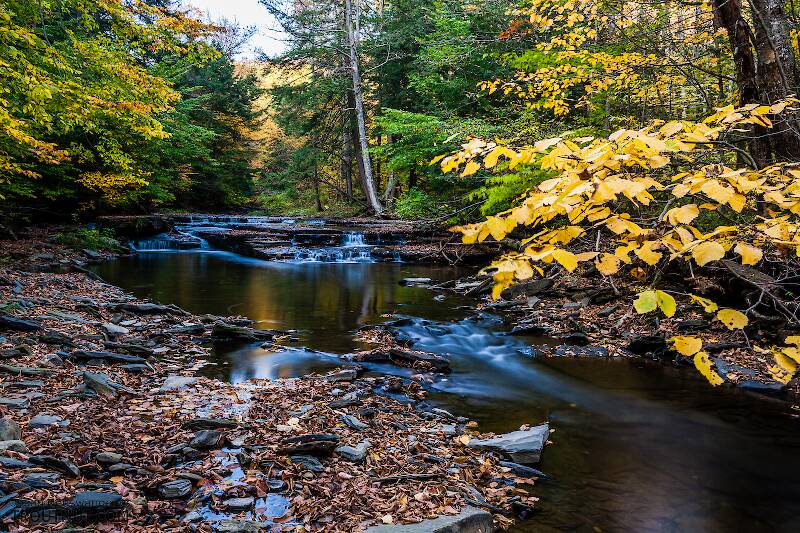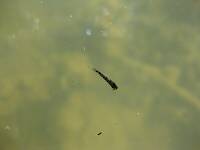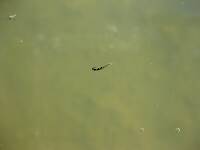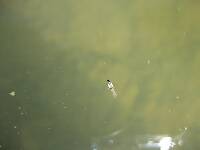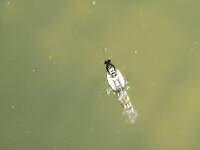
Salmonflies
Pteronarcys californica
The giant Salmonflies of the Western mountains are legendary for their proclivity to elicit consistent dry-fly action and ferocious strikes.
Featured on the forum

Nymphs of this species were fairly common in late-winter kick net samples from the upper Yakima River. Although I could not find a key to species of Zapada nymphs, a revision of the Nemouridae family by Baumann (1975) includes the following helpful sentence: "2 cervical gills on each side of midline, 1 arising inside and 1 outside of lateral cervical sclerites, usually single and elongate, sometimes constricted but with 3 or 4 branches arising beyond gill base in Zapada cinctipes." This specimen clearly has the branches and is within the range of that species.

Troutnut is a project started in 2003 by salmonid ecologist Jason "Troutnut" Neuswanger to help anglers and
fly tyers unabashedly embrace the entomological side of the sport. Learn more about Troutnut or
support the project for an enhanced experience here.
Shawnny3 on Jun 22, 2012June 22nd, 2012, 11:39 am EDT
I've been reading LaFontaine's book, and it's really interesting stuff. I don't usually notice fish feeding on caddis, though. I'll occasionally catch some fish on a larval pattern, but these are just searching patterns. I often see adults flying around, but I know that doesn't necessarily mean they are hatching or laying eggs.
Mayfly hatches are often, in my experience, pretty dependable, predictable, and easy to identify occurring. I know at certain times of year and at certain times of day what's likely to be going on even before I get to the stream. Can caddis hatches be this way, or are they harder to pin down in terms of times of year and times of day? What factors do they depend on? What do you look for to clue you in as to what's going on?
Thanks,
Shawn
Mayfly hatches are often, in my experience, pretty dependable, predictable, and easy to identify occurring. I know at certain times of year and at certain times of day what's likely to be going on even before I get to the stream. Can caddis hatches be this way, or are they harder to pin down in terms of times of year and times of day? What factors do they depend on? What do you look for to clue you in as to what's going on?
Thanks,
Shawn
Jewelry-Quality Artistic Salmon Flies, by Shawn Davis
www.davisflydesigns.com
www.davisflydesigns.com
Martinlf on Jun 22, 2012June 22nd, 2012, 1:54 pm EDT
Shawn, from my experience it depends on the stream. Grannoms on the Little J (typically in mid April) are relatively predictable, as they are on Fishing Creek and Penns, though fish seem to rise to dries more consistently on the J for this hatch. The Tulpehocken has relatively dependable daily caddis hatches starting around May 1 in a normal year. They go on for at least two months (I tend to get distracted by other bugs and stop focusing on the caddis by the end of June). For other streams, caddis dry fly fishing has been hit or miss for me, and caddis dries are more often a searching pattern, or something I pull out for a fish that doesn't want anything else. But I may just not know enough about other species and other waters. Others may know other dependable hatches.
"He spread them a yard and a half. 'And every one that got away is this big.'"
--Fred Chappell
--Fred Chappell
Entoman on Jun 22, 2012June 22nd, 2012, 6:09 pm EDT
from my experience it depends on the stream...
I agree with Louis, Shawn.
Mayfly hatches are often, in my experience, pretty dependable, predictable, and easy to identify occurring. I know at certain times of year and at certain times of day what's likely to be going on even before I get to the stream. Can caddis hatches be this way, or are they harder to pin down in terms of times of year and times of day? What factors do they depend on? What do you look for to clue you in as to what's going on?
You are right. They are hard to pin down and not because of less angler lore being accumulated and shared on the order. In my opinion, the biological factors involved in this difficulty are the reason that there's not as much shared about them to begin with. With some very notable exceptions, most caddis activity is more jumbled and often harder to detect (and hence deal with) than mayfly activity. Here's a typical early Summer day's experience on one of my local rivers I'll pose as an example of what I mean:
First light to 10am - Glossosoma larvae (Little Short-horned Sedge) engage en masse in behavioral drift. This doesn't happen every day. In fact, it's quite sporadic. I've gone quite a spell before without hitting it. There is no hatch involved so an angler without knowledge of this behavior (or lacking a seine net) is totally unaware. But the fish aren't...
10am till around noon - infrequens nymphs (Pale Morning Dun) are getting very active. A few duns begin to show alerting the angler to this activity for the use of nymphs.
Noon 'till almost 3pm - infrequens duns hatch in earnest with ebbs and flows. There are other critters about (a few caddis, baetids, etc.), but not enough to distract Mr. Trout from his focus on the ephemerellids that are everywhere. The fish get very dialed in to this critter and the options can be reduced to a couple of stages and behavior of this single species. Crack the code and it's hammer time.
3pm 'till around 7pm - Activity drops off. There is the odd fish looking for terrestrials or hangover duns and prospecting with flies is still working, but time is perhaps better spent with lunch and a nap in preparation for the evening (which is what I chose to do :)).
7pm 'till dusk - the time for caddis. Herein lies the rub. There are at least 4 species active. A couple of hydropsychiids (Spotted Sedge), at least one rhyacophilid (Green Sedge) and a small dark species of another family thrown in. The day's hatching pupa trickling off are mixing with a weeks worth of females returning to lay eggs; some diving, some dancing on the surface. The air is filled with flying caddis, most of which won't end up anywhere near the water. Which species and stage are the fish focusing on? Are individual fish working on different ones? These are the times when anglers are often reduced to "chuck and chance it", with options hopefully reduced by previous experience, seining, and rise observation. Sometimes you hit the magic formula, sometimes you don't (I had mixed results this night, though two days before under what appeared to be very similar circumstances green soft hackles and pupa really did the trick).
Dusk 'till you can't see anymore - Suddenly the caddis patterns quit working completely and if anything the fish are even more active, though the rise forms have changed. It's too dark to really see what's in the air, so I broke out the seine to discover a spinnerfall of large Siphlonurus (Gray Drake). I was back in business for a few more fish.
Anyway, I hope this illustrated the point I was trying to make.
"It's not that I find fishing so important, it's just that I find all other endeavors of Man equally unimportant... And not nearly as much fun!" Robert Traver, Anatomy of a Fisherman
PaulRoberts on Jun 23, 2012June 23rd, 2012, 6:08 am EDT
I've been able to get a rough bead on several different caddis. But as others have said, it's not easy bc they’re not so visible to us, or just as importantly, they may not be vulnerable to trout. Trout focus on what's worth the effort and many caddis are simply not vulnerable. Some are, but just when in the life cycle they are vulnerable varies with group, and by stream as some streams offer more habitat for some species than others. And, except for a few, a simple dry fly, or just dead-drifting a "nymph" won’t usually cover the activity. Within a given stage, and across groups, behavior varies tremendously which affects availability or vulnerability.
I've been able to take advantage of some (from memory –ones whose names generate some excitement within –although there might be others in my journals I'm forgetting). The subject is large, but I’ll add a few notes of the stages I remember making use of:
New York:
Glossosoma –larva
Rhyacophila –larva, pupa (I think)
Psilotreta –cased larva, pupa, adults (dry)
Hydropsyche –pupa, diving adult
Cheumopsyche –pupa, dry adult
Brachycentrus –cased larva, pupa, dry adult, spent adult (why it’s a “super-hatch –bc it lends itself to “mayfly tactics”).
Mystacides –pupa (I think, as I have damp/emerger pupae in my box), adult/spent dry –a bear, casting close to shoreline cover to mostly small fish, but the trout have been there on them. Fun.
Neophylax –cased larva, dry adult –close to shoreline vegetation in fall
Pycnopsyche –hmmmmm…. Not remembering them now –I believe I found adults in fall close to shorelines –but I’m not sure I’m not mixing that up with Neophylax. Might have to check into my journals why that name makes my heart twinge.
Here in the west I’ve fished MUCH less, and haven’t had banner days with caddis yet -when I took obvious advantage of caddis activity and had it pay off beyond “search pattern” work. The notable exception is Brachycentrus, both with cased larvae and dry. Oh yes, and Rhyaco larvae.
I’m aware of many caddis that live in my streams here and have read up on their behaviors, but must wait until I can attend to my streams more before I can actually make use of that (surface) knowledge. I’ve been hoping to take advantage of Arctopsyche activity some year, and this was possibly the year since they emerge about the time of snowpack runoff when streams become unfishable (in any “normal” FF sense). This year was it with snowpack so thin, but alas, I just haven’t been able to get away from my duties as Husband/Father.
Hope this helps a little. Here’s a plan of action:
-Sample your streams and see who's there. Adults pretty much need to be captured too, so you can get a bead on proper behavior and track the activity.
-Read up on their habitat needs and behavior –all stages–and their seasonal and daily timing.
-Keep your eyes peeled at the right times and places.
-Be a creative tier, able to revisit the area the next day to experiment.
I’d say caddis take more knowledge (of the unseen), and stream time, to take advantage of compared to mayflies. But…use this plan of action for mays too and you’ll find their just isn’t time in one’s life for all the gloriousness that’s out there to be a part of. You will then die unfulfilled, but happy. My last words, after I’ve said goodbye to loved ones, will probably be …. “Psilotreta!”… “Neophylax!” …. “Hydropsy……..” .
I've been able to take advantage of some (from memory –ones whose names generate some excitement within –although there might be others in my journals I'm forgetting). The subject is large, but I’ll add a few notes of the stages I remember making use of:
New York:
Glossosoma –larva
Rhyacophila –larva, pupa (I think)
Psilotreta –cased larva, pupa, adults (dry)
Hydropsyche –pupa, diving adult
Cheumopsyche –pupa, dry adult
Brachycentrus –cased larva, pupa, dry adult, spent adult (why it’s a “super-hatch –bc it lends itself to “mayfly tactics”).
Mystacides –pupa (I think, as I have damp/emerger pupae in my box), adult/spent dry –a bear, casting close to shoreline cover to mostly small fish, but the trout have been there on them. Fun.
Neophylax –cased larva, dry adult –close to shoreline vegetation in fall
Pycnopsyche –hmmmmm…. Not remembering them now –I believe I found adults in fall close to shorelines –but I’m not sure I’m not mixing that up with Neophylax. Might have to check into my journals why that name makes my heart twinge.
Here in the west I’ve fished MUCH less, and haven’t had banner days with caddis yet -when I took obvious advantage of caddis activity and had it pay off beyond “search pattern” work. The notable exception is Brachycentrus, both with cased larvae and dry. Oh yes, and Rhyaco larvae.
I’m aware of many caddis that live in my streams here and have read up on their behaviors, but must wait until I can attend to my streams more before I can actually make use of that (surface) knowledge. I’ve been hoping to take advantage of Arctopsyche activity some year, and this was possibly the year since they emerge about the time of snowpack runoff when streams become unfishable (in any “normal” FF sense). This year was it with snowpack so thin, but alas, I just haven’t been able to get away from my duties as Husband/Father.
Hope this helps a little. Here’s a plan of action:
-Sample your streams and see who's there. Adults pretty much need to be captured too, so you can get a bead on proper behavior and track the activity.
-Read up on their habitat needs and behavior –all stages–and their seasonal and daily timing.
-Keep your eyes peeled at the right times and places.
-Be a creative tier, able to revisit the area the next day to experiment.
I’d say caddis take more knowledge (of the unseen), and stream time, to take advantage of compared to mayflies. But…use this plan of action for mays too and you’ll find their just isn’t time in one’s life for all the gloriousness that’s out there to be a part of. You will then die unfulfilled, but happy. My last words, after I’ve said goodbye to loved ones, will probably be …. “Psilotreta!”… “Neophylax!” …. “Hydropsy……..” .
Entoman on Jun 23, 2012June 23rd, 2012, 9:26 am EDT
Very good points, Paul. Yes, availabilty is another important factor I didn't focus on too much above but you are absolutely right in my experience. I hinted at it but will expand a little here. Perhaps the biggest behavioral differences between the two orders are caused (or rather made possible) by the single most important physical difference. Adult caddis can take nourishment as adults - mayflies can't. This is why caddis emergences can trickle off in relatively small numbers and yet build up tremendously for mating flights. A mayflies adult life is measured in days not weeks like a caddis, so their emergences must be more concentrated. As far as methods of emergence and timing, both orders are all over the map on this. The major difference I think is more of a numbers game and the fact that caddis species are more prone to overlapping their mid-Summer emergences and swarms as mentioned above. As to the exceptions, a western list would look very similar to your eastern one:
Glossosoma (Short-horned Sedge) –larva
Rhyacophila (Green Sedge) –larva, pupa, adult
Hydropsyche (Spotted Sedge)– larva, pupa, diving adult, adult
Cheumopsyche (Little Sister Sedge) – pupa, dry adult
Brachycentrus (Grannom, Mother's Day Caddis) – cased larva, pupa, dry adult, spent adult and often hatches in isolation.
Amiocentrus (Weedy Water Sedge) - same comments as for Grannom except spring creek habitat.
Lepidostoma (Brown Sedge) - cased larva, pupa, adult
Dicosmoecus (October Caddis) - cased & uncased larvae, pupa, adult
Phryganea (Rush Sedge) - stillwater habitat, cased & uncased larvae, pupa, adult
Banksiola (Travelling Sedge) - stillwater habitat, cased & uncased larvae, pupa, adult
Glossosoma (Short-horned Sedge) –larva
Rhyacophila (Green Sedge) –larva, pupa, adult
Hydropsyche (Spotted Sedge)– larva, pupa, diving adult, adult
Cheumopsyche (Little Sister Sedge) – pupa, dry adult
Brachycentrus (Grannom, Mother's Day Caddis) – cased larva, pupa, dry adult, spent adult and often hatches in isolation.
Amiocentrus (Weedy Water Sedge) - same comments as for Grannom except spring creek habitat.
Lepidostoma (Brown Sedge) - cased larva, pupa, adult
Dicosmoecus (October Caddis) - cased & uncased larvae, pupa, adult
Phryganea (Rush Sedge) - stillwater habitat, cased & uncased larvae, pupa, adult
Banksiola (Travelling Sedge) - stillwater habitat, cased & uncased larvae, pupa, adult
"It's not that I find fishing so important, it's just that I find all other endeavors of Man equally unimportant... And not nearly as much fun!" Robert Traver, Anatomy of a Fisherman
PaulRoberts on Jun 23, 2012June 23rd, 2012, 9:35 am EDT
Good points, Kurt.
Entoman on Jun 23, 2012June 23rd, 2012, 10:08 am EDT
Oh, and one other point from an organizational perspective. I generally have my boxes organized by hatches for the highly imitative flies. Caddis is the only order where for me this isn't the case. Because their larvae aren't associated with hatches, I keep my larval imitations in general nymph boxes that are organized by water type. This insures that I will have larval imitations available without having to drag around all the pupa & adult imitations when I'm pretty sure there won't be any need for them. For example, some of the rivers I poke around on early in the year fish very well with Hydro larvae on the dropper and this is sometimes weeks/months before any serious hatching activity. Same with lakes and the big motorboat species. This is especially true with October Caddis where the larvae can be a hot item all spring through early Summer. No sense carrying around a big box of giant imitative dry flies & pupa that won't be needed until the Fall...:)
"It's not that I find fishing so important, it's just that I find all other endeavors of Man equally unimportant... And not nearly as much fun!" Robert Traver, Anatomy of a Fisherman
Shawnny3 on Jun 25, 2012June 25th, 2012, 8:04 am EDT
Thanks so much for the info, guys. Very helpful things to keep in mind. I especially appreciated the point about caddisflies being able to feed as adults, which scatters their emergence and egglaying in sometime unpredictable ways. That's something I hadn't considered and explains a lot. Would flyfishing be more or less fun if the same were true for mayflies? I'm not sure the answer would be the same for everyone, but it sure would be a trickier puzzle.
I don't expect to find important caddis activity often. It seems to me, then, that soft-hackles present the simplest way to be prepared for the range of possible caddis situations that might arise on the stream. They could pass as larvae, pupae, or egg-laying adults and can be fished in myriad ways. Does that seem like a good place to concentrate my tying energies?
-Shawn
I don't expect to find important caddis activity often. It seems to me, then, that soft-hackles present the simplest way to be prepared for the range of possible caddis situations that might arise on the stream. They could pass as larvae, pupae, or egg-laying adults and can be fished in myriad ways. Does that seem like a good place to concentrate my tying energies?
-Shawn
Jewelry-Quality Artistic Salmon Flies, by Shawn Davis
www.davisflydesigns.com
www.davisflydesigns.com
Entoman on Jun 25, 2012June 25th, 2012, 9:28 am EDT
Shawn,
Yes, though I wouldn't give up on dries all together. Here's a dry pattern that has worked very well for me as a general caddis dry. I trim the hackle underneath for a flush float if the situation demands. The bodies of caddis are generally much shorter than the wings. I don't like the stiff wing sticking out too far beyond the bend for better hookups, so I just tie the bodies short.
Hairwing Caddis, olive green #18



... soft-hackles... present the simplest way to be prepared for the range of possible caddis situations that might arise on the stream. They could pass as larvae, pupae, or egg-laying adults and can be fished in myriad ways. Does that seem like a good place to concentrate my tying energies?
Yes, though I wouldn't give up on dries all together. Here's a dry pattern that has worked very well for me as a general caddis dry. I trim the hackle underneath for a flush float if the situation demands. The bodies of caddis are generally much shorter than the wings. I don't like the stiff wing sticking out too far beyond the bend for better hookups, so I just tie the bodies short.
Hairwing Caddis, olive green #18



"It's not that I find fishing so important, it's just that I find all other endeavors of Man equally unimportant... And not nearly as much fun!" Robert Traver, Anatomy of a Fisherman
PaulRoberts on Jun 25, 2012June 25th, 2012, 10:38 am EDT
Nice simple tie. I like that one.
Shawnny3 on Jun 26, 2012June 26th, 2012, 7:46 am EDT
That's a really pretty tie, Kurt. I love patterns that are simple and accurate. I've noticed that many caddis patterns in books have bodies that are disproportionately large compared with the wing length (a consequence of applying mayfly proportions as a tying habit?) - you have a nice solution to that problem. I wonder how the hair lays so flat. Is it because the wraps over it are relatively loose, or is it not a hollow hair at all? I like coastal deer hair because it doesn't compress and flare like whitetail and elk (though for that reason it isn't as buoyant, either). It also has really nice color patterning.
-Shawn
-Shawn
Jewelry-Quality Artistic Salmon Flies, by Shawn Davis
www.davisflydesigns.com
www.davisflydesigns.com
Entoman on Jun 26, 2012June 26th, 2012, 9:09 am EDT
Thanks guys.
Yes, hair selection is very important, Shawn. This particular pattern uses various selections of fine moose and/or yearling elk for the light ones. The hair is very hollow but also hard by comparison to deer. This allows for a fairly tight bundle. It is tied in very firm towards the front but the wraps towards the back are less firm and are more gathering wraps as you suspected. To stop the wing from easily twisting to the side (a problem with most hair wings), the thread under it against the shank must be firmly glued in place as well as the wraps covering the hair. The antennae are just affectations for esthetic reasons, but I like the looks of them. I leave in two to a side so that if one breaks off, I break one off the other side to keep it in balance. This hair is pretty tough, but if the fish manage to break them all off, I don't care too much as the fly has to be working pretty good for that to happen.:) I think the hair wing (if properly selected and tied in) gives the best over all silhouette. It lets the right amount of light through with the added bonus of creating a similar surface signature by simulating the straggling long legs as well. I have had days with this pattern where the fish responded well to it even though the rise forms showed the fish were clearly working sub-surface. That says a lot for its drawing power. If the fish are sipping fresh spents (still riding in a normal posture) on flat water I trim up the hackle underneath and thin it out a little as well. This seems to happen most on spring creeks with good populations of brachycentrids.
Yes, hair selection is very important, Shawn. This particular pattern uses various selections of fine moose and/or yearling elk for the light ones. The hair is very hollow but also hard by comparison to deer. This allows for a fairly tight bundle. It is tied in very firm towards the front but the wraps towards the back are less firm and are more gathering wraps as you suspected. To stop the wing from easily twisting to the side (a problem with most hair wings), the thread under it against the shank must be firmly glued in place as well as the wraps covering the hair. The antennae are just affectations for esthetic reasons, but I like the looks of them. I leave in two to a side so that if one breaks off, I break one off the other side to keep it in balance. This hair is pretty tough, but if the fish manage to break them all off, I don't care too much as the fly has to be working pretty good for that to happen.:) I think the hair wing (if properly selected and tied in) gives the best over all silhouette. It lets the right amount of light through with the added bonus of creating a similar surface signature by simulating the straggling long legs as well. I have had days with this pattern where the fish responded well to it even though the rise forms showed the fish were clearly working sub-surface. That says a lot for its drawing power. If the fish are sipping fresh spents (still riding in a normal posture) on flat water I trim up the hackle underneath and thin it out a little as well. This seems to happen most on spring creeks with good populations of brachycentrids.
"It's not that I find fishing so important, it's just that I find all other endeavors of Man equally unimportant... And not nearly as much fun!" Robert Traver, Anatomy of a Fisherman
Quick Reply
Related Discussions
Topic
Replies
Last Reply
4
Sep 14, 2007
by Mcjames
by Mcjames

